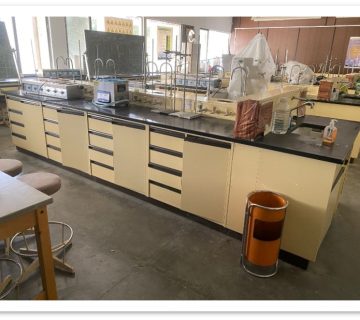The Chemical Engineering Department at the College of Engineering, University of Baghdad, held an MSc thesis examination titled:
“ Preparation and Characterization of Composite Metal Oxide Electrode for Organic Pollutant Removal from Wastewater “
On Tuesday 26-12 -2023
By the student Yamama Abdul kareem Ahmed and supervised by Asst. Prof. Dr Rasha Habeeb Salman. The examination committee consisted of Prof. Dr. Ammar S. Abbas as Chairman and the membership of Asst. Prof. Dr. Khalid W. Hameed, Asst. Prof. Dr. Atheer M. Al-yaqoobi, Asst. prof. Dr. Nada N. Abdulrazzaq and Asst. Prof. Dr. Forat Yasir Al-Jaberi.
After conducting the public discussion and listening to the student’s defense, the thesis was accepted. The thesis was summarized as follows:
Phenol and its derivatives are among the most dangerous organic contaminants that could be found in industrial wastewater that need to be removed from waste streams immediately. Electrochemical oxidation of organic substances is a promising method for treating wastewater. The economical and highly performed anode material is the critical factor affecting the efficiency of electro-oxidation toward organics. Electrodeposition of metal oxides on graphite substrates can improve their ability to remove organic substances. In this work, multicomponent oxides of Mn, Co, and Ni and binary component oxide of Co-Mn were electrochemically deposited anodically and cathodically on graphite substrate to enhance their performance in removing phenol. Formation of the metal oxide film was achieved within 2 h with different parameters: current densities of 20, 25, 30, and 35 mA/cm2 with (0.1/0.1/0.1) M of Co-Mn-Ni oxide or with (0.2/0.2) M of Co-Mn oxide and different metal salts concentration, i.e., Co(NO3)2, Ni(NO3)2, and MnCl2 of (0.05,0.1 and 0.15) M with a mixing ratio of 1:1:1 at 25 mA/cm2 and 0.2 M of Co(NO3)2 and MnCl2 with different mixing ratio (1:1, 2:1, and 1:2) at 25 mA/cm2 for better composite properties. The deposited layer of Co-Mn-Ni oxide and Co-Mn oxide were characterized by testing the surface structure, morphology, composition, and roughness. X-ray diffraction (XRD), scanning electron microscopy (SEM), energy dispersive X-ray (EDX), and Atomic force microscopy (AFM) techniques facilitated these tests. According to XRD results, the spinel Co3O4 and Cubic CoO, Cubic NiO, MnCo2O4, and Cubic, orthorhombic, and hexagonal MnO2, tetragonal Mn3O4 and cubic Mn2O3 were detected on the anode and the cathode electrodes. The roughness of binary and tertiary composite electrodes decreases with increasing current densities and concentration of metal salts. The composite films on the cathode electrodes are rougher than the anode’s films. The crystal sizes are affected by electrodeposition parameters which increase with increasing metal salt concentration and decrease slightly with increasing current densities. The removal of phenol by indirect electrochemical oxidation from simulated wastewater containing 150 mg/L of phenol (equal to 320 mg/L of chemical oxygen demand (COD)) using the prepared electrodes of tertiary Co-Mn-Ni oxide and binary Co-Mn oxide electrodes was investigated. According to characterization results and primary phenol removal experiments, the composite electrodes have synthesized with (0.05/0.05/0.05) M of tertiary Co/Mn/Ni salts at 25 mA/cm2 and the cathode that synthesized with (0.2/0.2) M of binary Co/Mn salts at 25 mA/cm2 were chosen as the anode in the indirect electro-oxidation. The effectiveness of composite electrodes was examined at current densities of 40, 60, and 80 mA/cm2 , pH values of 3, 4, and 5, and NaCl concentration of 1, 1.5, and 2 g/L with an electrolysis time of 1 h for tertiary composite electrodes and of 3 h for binary composite electrodes. The process parameters were optimized through response surface methodology (RSM) in conjunction with Central Composite Design (CCD), where the COD was chosen as a response function. With using Co/Mn/Ni oxide electrodes the optimal current density, NaCl concentration, and pH magnitude of 80 mA/cm2 , 1.717 g/L, and pH = 3. The efficiency of COD elimination of 99.995% was attained after 1 hour of indirect electrochemical oxidation with an energy consumption of 158.341 kWh/kg COD. While using Co/Mn oxide electrode the optimal current density, NaCl concentration, and pH magnitude of 80 mA/cm2 , 1.6868 g/L, and pH = 3, respectively. The efficiency of COD elimination of 99.21% was attained after 3 hours of indirect electrochemical oxidation with an energy consumption of 504.279 kWh/kg COD. The results showed that the removal efficiency of phenol increased with the increase in current densities and NaCl concentration, while it decreased with increasing of alkalinity. The highest obtained removals efficiency were 99.995% and 99.1475% which reflected a tremendously high performance of multicomponent composite and binary composite for phenol removal and reducing electrolysis time compared to previous studies. The multicomponent electrode is considered more effective than the binary composite electrode with less electrolysis time and less energy consumption. To understand the processes of phenol oxidation in electrochemical systems, a first order kinetics model for phenol elimination has been presented; this model has yielded excellent results. The values of the reaction rate constants for the indirect electrooxidation process of phenol using Co-Mn oxide and Co-Mn-Ni oxide are greater than the reaction rate constants in previous studies using single metal oxide








